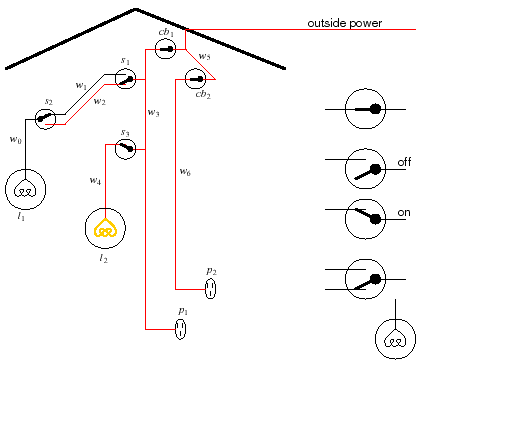Third edition of Artificial Intelligence: foundations of computational agents, Cambridge University Press, 2023 is now available (including the full text).
1.6.2 A Diagnostic Assistant
A diagnostic assistant is intended to advise a human about some particular system such as a medical patient, the electrical system in a house, or an automobile. The diagnostic assistant should advise about potential underlying faults or diseases, what tests to carry out, and what treatment to prescribe. To give such advice, the assistant requires a model of the system, including knowledge of potential causes, available tests, and available treatments, and observations of the system (which are often called symptoms).
To be useful, the diagnostic assistant must provide added value, be easy for a human to use, and not be more trouble than it is worth. A diagnostic assistant connected to the Internet can draw on expertise from throughout the world, and its actions can be based on the most up-to-date research. However, it must be able to justify why the suggested diagnoses or actions are appropriate. Humans are, and should be, suspicious of computer systems that are opaque and impenetrable. When humans are responsible for what they do, even if it is based on a computer system's advice, they should have reasonable justifications for the suggested actions.
In terms of the black box definition of an agent in Figure 1.3, the diagnostic assistant has the following as inputs:
- prior knowledge, such as how switches and lights normally work, how diseases or malfunctions manifest themselves, what information tests provide, and the effects of repairs or treatments.
- past experience, in terms of data of previous cases that include the effects of repairs or treatments, the prevalence of faults or diseases, the prevalence of symptoms for these faults or diseases, and the accuracy of tests. These data are usually about similar artifacts or patients, rather than the actual one being diagnosed.
- goals of fixing the device and trade-offs, such as between fixing or replacing different components, or whether patients prefer to live longer if it means they will be in pain or be less coherent.
- observations of symptoms of a device or patient.
The output of the diagnostic assistant is in terms of recommendations of treatments and tests, along with a rationale for its recommendations.

Each dimension is relevant to the diagnostic assistant:
- Hierarchical decomposition allows for very-high-level goals to be maintained while treating the lower-level causes and allows for detailed monitoring of the system. For example, in a medical domain, one module could take the output of a heart monitor and give higher-level observations such as notifying when there has been a change in the heart rate. Another module could take in this observation and other high-level observations and notice what other symptoms happen at the same time as a change in heart rate. In the electrical domain, Figure 1.8 is at one level of abstraction; a lower level could specify the voltages, how wires are spliced together, and the internals of switches.
- Most systems are too complicated to reason about in terms of the states, and so they are usually described in terms of the features or individual components and relations among them. For example, a human body may be described in terms of the values for features of its various components. Designers may want to model the dynamics without knowing the actual individuals. For example, designers of the electrical diagnosis system would model how lights and switches work before knowing which lights and switches exist in an actual house and, thus, before they know the features. This can be achieved by modeling in terms of relations and their interaction and by adding the individual components when they become known.
- It is possible to reason about a static system, such as reasoning about what could be wrong when a light is off given the position of switches. It is also possible to reason about a sequence of tests and treatments, where the agents keep testing and treating until the problem is fixed, or where the agent carries out ongoing monitoring of a system, continuously fixing whatever gets broken.
- Sensing uncertainty is the fundamental problem that faces diagnosis. Diagnosis is required if an agent cannot directly observe the internals of the system.
- Effect uncertainty also exists in that an agent may not know the outcome of a treatment and, often, treatments have unanticipated outcomes.
- The goal may be as simple as "fix what is wrong," but often there are complex trade-offs involving costs, pain, life expectancy, the probability that the diagnosis is correct, and the uncertainty as to efficacy and side effects of the treatment.
- Although it is often a single-agent problem, diagnosis becomes more complicated when multiple experts are involved who perhaps have competing experience and models. There may be other patients with whom an agent must compete for resources (e.g., doctor's time, surgery rooms).
- Learning is fundamental to diagnosis. It is through learning that we understand the progression of diseases and how well treatments work or do not work. Diagnosis is a challenging domain for learning, because all patients are different, and each individual doctor's experience is only with a few patients with any particular set of symptoms. Doctors also see a biased sample of the population; those who come to see them usually have unusual or painful symptoms.
- Diagnosis often requires a quick response, which may not allow for the time to carry out exhaustive reasoning or perfect rationality.



